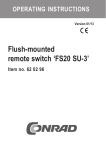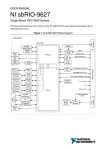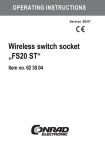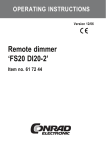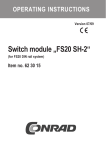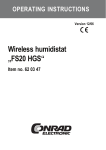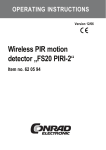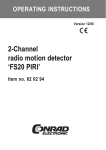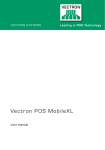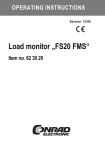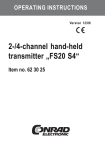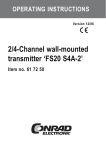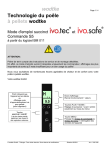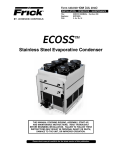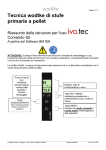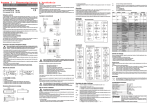Download 2-/4-Channel flush-mounted transmitter `FS20 S4U`
Transcript
OPERATING INSTRUCTIONS Version 12/06 2-/4-Channel flush-mounted transmitter ‘FS20 S4U’ Item no. 62 02 95 Introduction Dear customer, Thank you for purchasing this product. This product meets the requirements of both current European and national guidelines. In order to preserve this condition and ensure the safe operation of the product we kindly ask you to carefully follow these operating instructions! Please read the operating instructions completely and observe the safety and operation notes before using the product! All company names and product names contained herein are trademarks of the respective owners. All rights reserved. Should you have any further questions, please contact our technical advisory service: Germany: Tel. no.: +49 9604 / 40 88 80 Fax. no.: +49 9604 / 40 88 48 e-mail: [email protected] Mon. to Thur. 8.00am to 4.30pm Fri. 8.00am to 2.00pm 2 Table of contents Page 1. 2. 3. 4. 5. 6. 7. 8. 9. 10. 11. 12. 13. Prescribed use ............................................................................................................... 4 Scope of delivery ........................................................................................................... 4 Explanation of icons ...................................................................................................... 4 Technical specifications and features .......................................................................... 5 Safety instructions ......................................................................................................... 5 Preparing for operation, installation .............................................................................. 7 Operation ..................................................................................................................... 10 a) Basic functions ...................................................................................................... 10 b) Using several transmitters ................................................................................... 11 c) Timer function in 4-channel operation ................................................................. 11 d) 2-Channel operation ............................................................................................. 12 e) Timer function in 2-channel operation ................................................................. 12 f) Switching between 2-channel and 4-channel operation .................................... 12 FS20 address system basics ...................................................................................... 13 Integrating the wireless transmitter into the address system, programming ............ 15 a) Setting the house code ........................................................................................ 15 b) Setting the addresses ........................................................................................... 15 Programming a single address in 4-channel operation ...................................... 16 Programming a single address in 2-channel operation ...................................... 16 Assigning function groups and master addresses .............................................. 17 c) Example of an address assignment .................................................................... 18 Handling ....................................................................................................................... 20 Disposal ....................................................................................................................... 21 Tips and notes ............................................................................................................. 21 Declaration of conformity (DOC) ................................................................................. 22 3 1. Prescribed use The 2/4-channel flush transmitter ‘FS20 S4U’ is only intended for use with the FS20 wireless control system; it can remotely control devices on two or four channels. It must be installed and operated in a flush-mounted socket. When installed in a deep flush-mounted box, it can also be installed behind a flat installation switch/button. The device can be operated using any installation buttons. Four buttons are directly located on the device. This makes it easy and convenient to program the device. Any use other than the one described above may damage the product and can also increase the risk of short-circuit, fire, electric shock, etc. No part of the product may be modified or adapted. All the safety instructions and installation notes in this manual must be observed without fail. 2. Scope of delivery • 2/4-channel flush-mounted transmitter • User manual 3. Explanation of icons The icon with a lightning flash in a triangle is used to alert you to potential personal injury hazards such as electric shock. The icon with an exclamation mark in a triangle points to important instructions in this user manual that must be observed. 4 The ‘hand’ symbol provides special information and advice on operating the device. 4. Technical specifications and features • Operating voltage: ................................ 230 V~/50 Hz • Reception frequency: ........................... 868.35 MHz • Range: ................................................... up to 50m (in free-field) • Dimensions: .......................................... 32mm x 57mm (diameter) • Devices are remotely controllable on 2 channels (two buttons per channel) or 4 channels (one button per channel) • Very secure data transfer as a result of extensive coding and address assignment options. These also allow several neighbouring systems to be operated without interfering with each other 5. Safety instructions The product’s guarantee becomes invalid if the product is damaged as a result of failure to observe these operating instructions. We do not assume any liability for any resulting damages! Nor do we assume liability for damage to property or personal injury caused by improper use or failure to observe the safety instructions. In such cases the product’s guarantee becomes invalid! • Do not use this product in hospitals or medical institutions. Although the FS20 wireless control system only emits relatively weak radio signals, these may cause life-support systems to malfunction. This may also be the case in other areas. • For safety and licensing (CE) reasons any unauthorised alterations to and/or modification of the product are not permitted. • Voltage/power may only be supplied via the public power supply (230V~/50Hz). • This product is not a toy. Devices operated via the supply voltage should be kept out of the reach of children. Therefore, take particular care when children are around. • Do not leave packaging material lying around. This may become a dangerous plaything in the hands of children. 5 • To connect the device to the supply voltage as well as the consumer load or loads, work must be carried out on the supply voltage or on live voltage-carrying parts. First of all, switch off the electric circuit in which the wireless transmitter is to be included. For this purpose switch off the respective circuit breaker or remove the mains fuse in the house distribution. Make sure that nobody accidentally switches on the electrical circuit (safety warning on the in-house distributor, mechanical block, etc.). Then use a suitable measuring device, to check whether the affected electric circuit is fully voltage-free. • Standard operation of the product is only permitted, if it is correctly installed in an installation box. The installation box must have a suitable cover. • Only people who are appropriately trained are permitted to carry out work on voltagecarrying parts. If you are not appropriately trained, please consult a qualified electrician who is authorised to carry out such work. • Only use approved installation cables. Flexible cables are not permitted in fixed installations. The only exceptions here are the three control cables that are soldered to the device and that come fitted with wire-end sleeves to ensure correct wiring. If you need to lengthen the control cables, you must use suitable terminal strips. Do not shorten the control cables! All the FS20 S4U’s unused cable ends must be insulated (e.g., using junction box terminals) and not connected anywhere. • The product may only be used in dry indoor areas. • The accident-prevention regulations, established by the Employer’s Liability Insurance Association for electrical equipment and facilities, must be adhered to in commercial facilities. • Consult a skilled technician if you have doubts about the mode of operation, safety or connection of the device. • Handle the product with care; knocks, blows or even a fall from a low height can damage it. 6 6. Preparing for operation, installation Before assembling and using the device, make sure you take note of all the safety and assembly instructions in this user manual. Only people who are appropriately trained are permitted to carry out work on voltage-carrying parts. If you are not appropriately trained, please consult a qualified electrician who is authorised to carry out such work. Any incorrect work carried out on the supply voltage may lead to a fatal electric shock. Not only do you endanger your life, you also endanger the life of others! Only use approved installation cables for connecting the device. The installation location is, amongst other things, determined by two important factors: • Any cabling that may already exist • Good radio reception We therefore recommend that you test the radio reception at the installation location. When installing the device please make absolutely sure that you carry out the steps in the following order! a) First of all, switch off the electric circuit in which the wireless transmitter is to be included. For this purpose switch off the respective circuit breaker or remove the mains fuse in the house distribution. Make sure that nobody accidentally switches on the electrical circuit (safety warning on the in-house distributor, mechanical block, etc.). Then use a suitable measuring device, to check whether the affected electric circuit is fully voltage-free. b) Strip the skinners of the power cable and the cables to buttons 3 and 4 to a length of 8 mm, without damaging the bare wires in the process. Please note that no flexible wires are permitted in fixed installations. The only exceptions here are the three control cables that are soldered to the device and that come fitted with wire-end sleeves to ensure correct wiring. 7 c) Wire the wireless transmitter with the installation cables as shown in the diagram below. Unused wire ends should be insulated (e.g., with junction box terminals)! Check that all connections are securely fixed to the installation terminals. Do not shorten the button cables or wire-end sleeves! You can lengthen the cables using terminal strips or junction box terminals. 1 4 2 T4 sw T4 T3 T3 3 ge NL FS20 S4U 1, 2, 3, 4 Buttons 1, 2, 3 and 4 bk black cable ye yellow cable rd red cable N, L 230V~/50Hz supply voltage 8 rt N 230V~/50Hz L The buttons ‘1’, ‘2’, ‘l’ and ‘m’ on the device are connected in parallel with the external buttons. Button ‘1’: rd/bk, ‘2’: ye/bk, ‘3’: T3/bk, ‘ 4’: T4/bk d) Insert the wireless transmitter into the installation box. When doing this, bear in mind that the wireless transmitter should be inserted so that the integrated buttons are not inadvertently pressed, e.g., when presetting an installation button (if a deep installation box is used). e) Install the required number of control buttons in the installation boxes provided for them. You can select the number of buttons according to your own requirements, e.g., only one button (button ‘1 ’). If fewer than four buttons are installed, programming can be carried out via the buttons ‘1’, ‘ 2’, ‘3’ and ‘4’, which are integrated into the device. If the wireless transmitter is used as a 2-channel transmitter (each with a button combination for ‘ON/OFF’ or dim up/dim down), the two button combinations ‘1’ & ‘2’ and ‘3’ & ‘4’ belong together. f) Switch on the supply voltage. Caution! If you wish to use the buttons, which are integrated into the wireless transmitter for programming, make sure that all the conductive parts in the terminal or distribution box, such as wire ends, terminal strips, etc. are positioned so that they cannot be contacted when the buttons are pressed. Only press the buttons: Do not reach into the terminal box! Otherwise, there is risk of a fatal electric shock! 9 7. Operation Please note: In the delivery state the components of the FS20 wireless control system (a wireless switch socket, for example) do not respond to remote control commands from the wireless transmitter. They must first be addressed according to the instructions provided in the respective device’s user manual. Only afterwards can the functions be controlled. a) Basic functions Buttons are pressed quickly (switch) or for longer than 0.4 seconds (dim), as required. Each of the four buttons is preassigned to a different channel (4-channel operation). • Switching Pressing a button quickly (for fewer than 0.4 seconds) sends a TOGGLE command (changing between two switch states). • Dimming If a button is pressed for longer than 0.4 seconds, the corresponding dim command (‘DIMUP & DIM-DOWN’) is sent until the button is released. When the ‘DIM-UP & DIM-DOWN’ command is issued a lamp is dimmed up to the maximum and then dimmed down to the minimum, etc. The ‘dim direction’ is always the opposite direction to the command that was previously sent. If, for example, the last command caused a lamp to dim up, then pressing the button again would result in the lamp dimming down. Now you can program and operate the basic functions of the FS20 components. 10 Please also read the following sections and subsections, if you require an extended system with several components or you wish to use the additional functions. b) Using several transmitters In the delivery state each transmitter in the FS20 wireless control system has its own, randomly set house code. If you want to jointly control one or several receivers via different transmitters, you first need to coordinate the transmitters’ house codes. The same house code must be set for each transmitter. Make sure you coordinate or set this shared house code for all the transmitters before programming the receivers for the first time, as the associated house code is also sent to the receiver during this procedure. The transmitters’ channels are already set to the same addresses and only need to be changed if required, for example, if you are using an extensive FS20 wireless control system with numerous receivers/transmitters. See the relevant example in section 9. c). c) Timer function in 4-channel operation For programming the receiver’s timer function, buttons ‘1’/‘2’ or ‘ 3’/‘4’ constitute a button combination. Proceed as follows to program the device: • Press and hold down the button that is assigned to the receiver. • Press the other button of the button combination for one to five seconds (1 sec to 5 sec) and then release it. • Only afterwards should you release the button that you pressed first. These steps apply to starting as well as to stopping the timer programming. For information on how to program the timer, see the instructions in the receiver’s user manual. 11 d) 2-channel operation The wireless transmitter can be operated as a 4-channel transmitter (default setting) as well as a 2-channel transmitter. In the case of 2-channel operation a button combination is assigned to each channel. Channel Buttons 1 ‘1’ and ‘2’ 2 ‘3’ and ‘4’ Here, the button combination ‘1’ and ‘3’ has the function ‘OFF’ or ‘dim down’, and the button combination ‘2’ and ‘4’ has the function ‘ON’ or ‘dim up’. c) Timer function in 2-channel operation In order to program a receiver’s timer function, proceed as follows: • Simultaneously press the button combination that is assigned to the receiver for one to five seconds (1 sec to 5 sec). This command is used to start as well as to stop the programming of the timer. For information on how to program the timer, see the instructions in the receiver’s user manual. f) Switching between 2-channel and 4-channel operation • Switching to 4-channel operation (four individual switching channels) Press buttons ‘2’ and ‘3’ simultaneously for at least five seconds. • Switching to 2-channel operation (two switching channels with two buttons each) Press buttons ‘1’ and ‘4’ simultaneously for at least five seconds. 12 Please note: Different operating and programming instructions apply when a double number of channels has been set! 8. FS20 address system basics The FS20 wireless control system operates with a ‘house code’. This means that your neighbour can also use the same wireless control system and the two systems will not interfere with each other (provided that the house code has been programmed differently). 256 different addresses can be set within a house code. These addresses are divided into four address types (available number is in brackets): • • • • Single addresses (225) Function group addresses (15) Local master addresses (15) Global master address (1) One address from each address type can be assigned to each receiver. This means that each receiver can respond to up to four different addresses, but only ever to one address per address type. If you need a receiver to respond to more than one transmitter, you can program the transmitters to the same address or, if different transmitter address types have been set, you can program the receiver consecutively to these different addresses. The individual address types have the following function: • Single addresses Each receiver should be set to a single address so that it can be controlled separately. • Function group addresses Several receivers are defined as a functional unit by being assigned to a function group address. If, for example, all the lamps in a house are assigned to a function group, then all the lamps in the entire house can be switched on or off by pressing one button. • Local master addresses Several receivers are spatially defined as one unit and controlled via the local master address. If, for example, all the receivers in a room are each allocated to a local master address, then all you need to do is press one button when leaving the room to switch off all the consumer loads in the room. • Global master address Several receivers are assigned to the global master address and are jointly controlled via this address. All the consumer loads can easily be switched off simply by pressing one single button when leaving a house, for example. 13 See the example in section 9. c). This address system opens up a variety of possibilities. You can even implement access authorisations by assigning three garage doors to different single addresses and a joint function group (‘garage doors’), for example. Several people can then each be given a hand-held transmitter with a relevant single address for one garage door, while all the garage doors can be opened via a hand-held transmitter with a programmed function group address, or all the doors can be automatically closed in the evening via an FS20 timer. 14 The various address types and addresses are only set on the transmitter and these settings are transmitted to the receivers via the address assignment. A receiver must be in programming mode in order for this address assignment to take place. 9. Integrating the wireless transmitter into the address system, programming The house code, an address group and a subaddress are used for coding the wireless transmitter and its switching channels. You can also use special address group assignments to program the wireless transmitter as a local or global master. Only the four buttons ‘1’, ‘2’, ‘3’ and ‘4’ are used for entering the eightdigit house code, the two-digit address groups and the two-digit subaddresses, see the figure in section 6. This addressing makes 225 single addresses, 15 function groups, 15 local master addresses and 1 global master address available within each house code to the wireless transmitter. a) Setting the house code Once the supply voltage has been switched on, the wireless transmitter selects a random house code. If required, this house code can be changed as follows: • Keep the ‘1’ and ‘3’ buttons pressed on the wireless transmitter for five seconds. • Now use the ‘1’, ‘2’, ‘ 3’ and ‘4’ buttons to enter your system’s eight-digit house code. This must be identical for all the remote control transmitters in the FS20 wireless control system (as a precaution, make a note of this code and keep it safe). Example: 23141342 (1= button ‘1’, 2= button ‘2’, 3= button ‘3’, 4= button ‘4’) • The programming mode ends automatically once you have entered the eighth digit. b) Setting the addresses A channel’s address comprises a two-digit address group and a two-digit subaddress (for example, 1131, address group 11, subaddress 31). The address group ‘11’ is factory set for all channels. If several transmitters are to be operated at the same time and control different receivers, then different addresses need to be set on the transmitters. 15 Programming a single address in 4-channel operation For programming, the buttons 1/2 and 3/4 constitute a button combination. To change the single address (address group/subaddress) for a single button, proceed as follows: • Press and hold the button to be programmed. • Then press the other button of the button combination and keep both buttons pressed simultaneously for a minimum of five seconds. • Then release both buttons. • Enter a two-digit address group and a two-digit subaddress using the ‘1’, ‘2’, ‘3’ and ‘4’ buttons. Example: 1431 (address group 14, sub-address 31) • The programming mode ends automatically once you have entered the fourth digit. The following address combinations are preassigned to the buttons: Buttons Address 1 11 11 2 11 12 3 11 13 4 11 14 Please note: The address group 44 and the subaddress 44 both have a particular meaning, see below. Programming a single address in 2-channel operation To change the single address (address group/subaddress) for a single button, proceed as follows: • Press the buttons of the respective button combination simultaneously for at least five seconds (channel 1: buttons ‘ 1’ and ‘2’, channel 2: buttons ‘3’ and ‘4’). • Then release both buttons again. • Enter a two-digit address group and a two-digit subaddress using the ‘1’, ‘2’, ‘3’ and ‘4’ buttons. Example: 1431 (address group 14, sub-address 31) • The programming mode ends automatically once you have entered the fourth digit. 16 16 Assigning function groups and master addresses • Function groups (44xx) If you enter 44 as the address group, then the subaddress (provided this is not also set to 44; see the following section) is defined as a function group. 15 different function groups between 4411 and 4443 can then be defined. Possible are: 4411, 4412, 4413, 4414, 4421, 4422, 4423, 4424, 4431, 4432, 4433, 4434, 4441, 4442, 4443 • Local master (xx44) If you only set the subaddress to 44, then this channel functions as a local master within the set address group. All receivers that are programmed with this local master address are controlled simultaneously. Possible are: 1144, 1244, 1344, 1444, 2144, 2244, 2344, 2444, 3144, 3244, 3344, 3444, 4144, 4244, 4344 • Global master (4444) If you set the address group and subaddress of a channel to 44, then this channel functions as a global master. All receivers that are programmed with this global master address are controlled simultaneously. The only global master is 4444. 17 17 c) Example of an address assignment When you require a large, extended system it is advisable to select addresses systematically so that you have an overview of the addresses that have already been assigned and so that you can jointly control the programmed receivers simply and meaningfully in groups. House code, e.g. 1234 1234 Global master address 4444 Function group 44xx e.g. 4411 ceiling lamps A Local master address, e.g. 1144 121 2 441 1 444 4 A different address group has been assigned to each room: • Room A: 11 • Room B: 12 An awning is also allocated to room B. • Room C: 13 • Room D: 14 18 D 112 2 114 4 444 4 113 1 114 4 444 4 B 121 1 111 1 114 4 441 1 444 4 141 2 444 4 141 1 441 1 444 4 C 131 1 441 1 444 4 Possible address groups are: 11, 12, 13, 14, 21, 22, 23, 24, 31, 32, 33, 34, 41, 42, 43 In order to be able to separately control each receiver, you need to program each receiver to a single address. A subaddress is also required in addition to the address group that is already selected (room A: 11, room B: 12, room C: 13, room D: 14). The following 15 subaddresses are possible for each address group: 11, 12, 13, 14, 21, 22, 23, 24, 31, 32, 33, 34, 41, 42, 43 In the example the awning is programmed to the single address 1211, which is comprised of the address group 12 and its subaddress 11. All the receivers in room A have also been programmed to a local master address (1144 in the example). For the local master address 44 is always set as the subaddress, while one of the 15 local master addresses (11, 12, 13, 14, 21, 22, 23, 24, 31, 32, 33, 34, 41, 42, 43) can be selected via the address group. Example: 1144, address group 11, subaddress 44 All the lamps in the house can be controlled via the global master address 4444. The awning was deliberately not programmed to this address and can therefore only be addressed via its single address (1211). It must be operated separately in this example. The ceiling lamps in all the rooms are also combined in a function group (4411 in the example, address group 44, subaddress 11) and can therefore be jointly controlled. To select one of the 15 function groups, you need to set 44 as the address group and a value between 11 and 43 (11, 12, 13, 14, 21, 22, 23, 24, 31, 32, 33, 34, 41, 42, 43) as the subaddress. 19 10. Handling The product should only be used in dry indoor areas. Never use the product immediately after it has been brought from a cold room into a warm one. The condensation that forms could damage the device! Allow the product to reach room temperature before mounting it and connecting it to the supply voltage. This may take several hours. Do not handle the product and the connected buttons/cables with damp or wet hands! Make sure that the insulation of the entire product is neither damaged nor destroyed. Always check the product for damage before using it! If you detect any damage, do NOT connect the product to the supply voltage! Life-threatening danger! If the product is not operated for a longer period, disconnect the product from the supply voltage. Avoid the following adverse ambient conditions at the installation location or during transport: - Moisture or excessive air humidity Extreme cold or heat Dust or flammable gases, vapours or solvents Strong vibrations Strong magnetic fields such as those found near machines or loudspeakers Operation of the wireless transmitter is only permitted, if it is correctly installed in an installation box. The device is completely maintenance-free. For this reason, you should never open it. Please let a professional workshop carry out the necessary maintenance and repairs! 20 11. Disposal When the product is no longer usable, dispose of it in accordance with the applicable statutory regulations. 12. Tips and notes Ranges and interference • The FS20 wireless control system works in the 868MHz range, which is also used by other radio services. Therefore devices that operate on the same or neighbouring frequency may restrict both its operation and its range. • The specified range of up to 50m is the free-field range, which means the range with visual contact between the transmitter and receiver. In practice, however, walls, ceilings, etc. between the transmitter and the receiver may affect and reduce the range. Other causes of reduced ranges: • All types of high-frequency interference • Any buildings or vegetation • Conductive metal parts that are located near the devices or within or near their transmission path, for example, radiators, metallised insulation glass windows, reinforced concrete ceilings, etc. • Influence on the radiation pattern of antennas due to the distance from the transmitter or receiver to conductive surfaces or objects (also to human bodies or the ground) • Broadband interference in urban areas that reduces the signal-to-noise ratio; the signal is no longer recognised due to this ‘noise’ • Interference radiation resulting from insufficiently shielded electronic devices, for example, operating computers or similar 21 13. Declaration of conformity (DOC) We, Conrad Electronic, Klaus-Conrad-Straße 1, D-92240 Hirschau (Germany), hereby declare that this product complies with the fundamental requirements and other relevant regulations of directive 1999/5/EG. 22 You can find the declaration of conformity for this product at www.conrad.com 23 http://www.conrad.com CONRAD IM INTERNET http://www.conrad.com Imprint These operating instructions are published by Conrad Electronic SE, Klaus-Conrad-Str. 1, D-92240 Hirschau/Germany. No reproduction (including translation) is permitted in whole or part e.g. photocopy, microfilming or storage in electronic data processing equipment, without the express written consent of the publisher. 100% recycling paper. Bleached without chlorine. The operating instructions reflect the current technical specifications at time of print.We reserve the right to change the technical or physical specifications. © Copyright 2006 by Conrad Electronic SE. Printed in Germany.
























